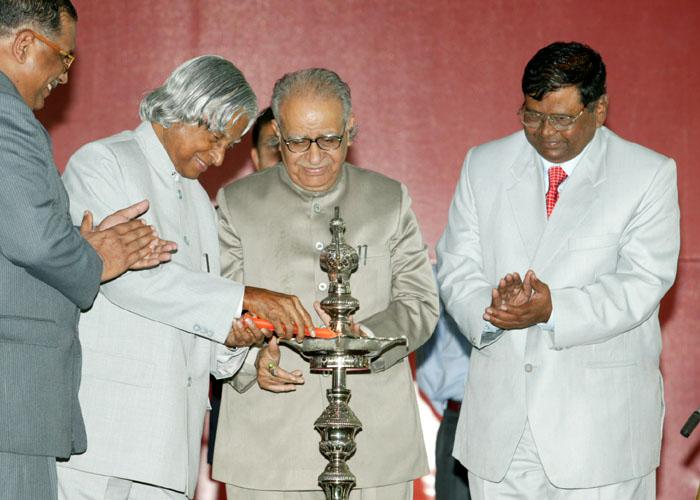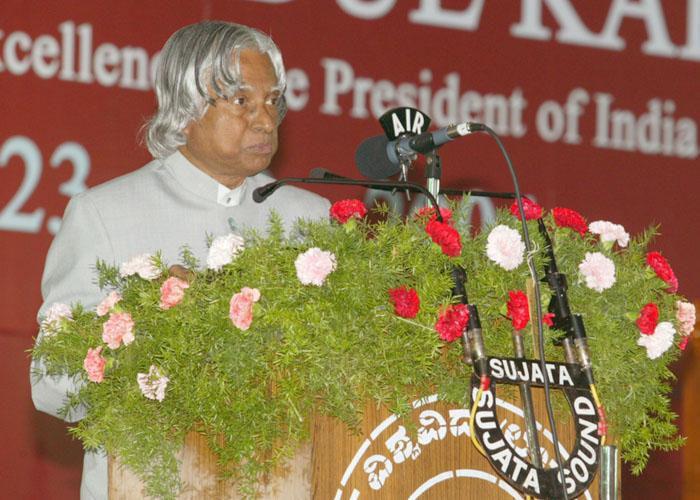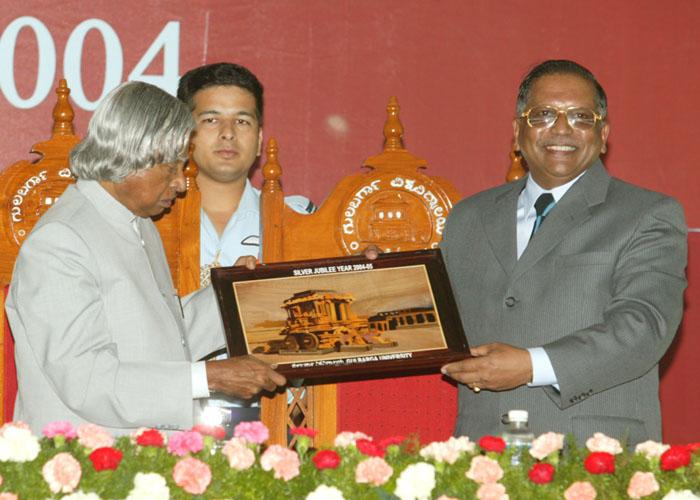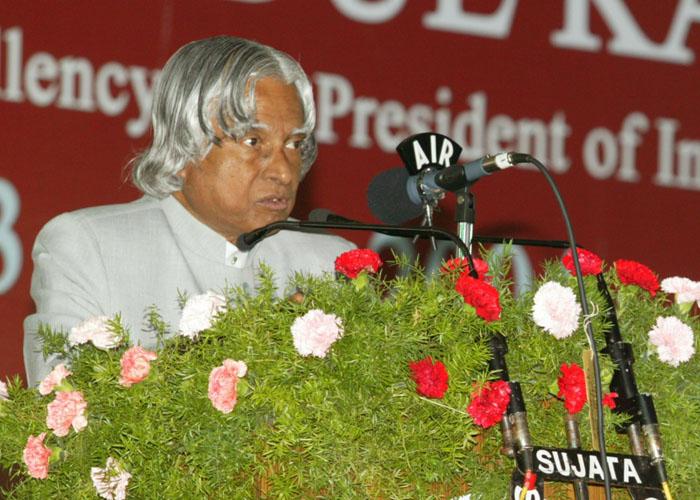Address At The Inauguration Of The Silver Jubilee Celebrations Of The Gulbarga University, Gulbarga
Gulbarga : 23-09-2004
Capacity Building through Education
I am indeed delighted to participate in the Silver Jubilee Celebrations of the Gulbarga University. I take this opportunity to congratulate the University students for their academic performance. I greet the Chancellor, Vice Chancellor, Professors, teachers and staff for shaping the young minds and preparing them to contribute to the nation in multiple fields. Dear graduates, when you complete your education in this university, the learning and in turn the empowerment will certainly assist you to meet the challenges in life. My best wishes.
Capacity building model
When the students come out of the University certain capacities are required to be built in them for enabling them to face the challenges in the real world, in their professional career and also facilitate their participation in the task of national development. I suggest that the ingredients for capacity building must be embedded right from the beginning of the students? life. A good educational model is the need of the hour to ensure that the students grow to contribute towards the economic growth of a nation. I am sure that the University has been paying attention to this need over the years. This can, however, be reinforced and be the Silver Jubilee Vision of the University.
For participating in the nation building tasks, the capacities required to be built among the students in their formative years by the educational institutions are: The capacity for research or inquiry, the capacity for Creativity and Innovation, particularly the creative transfer of knowledge, the capacity to use high technology, the capacity for Entrepreneurial Leadership and the capacity for Moral Leadership.
Research and enquiry
The 21st century is about the management of all the knowledge and information we have generated and the value addition we bring to it. We must give our students the skills with which they find a way through the sea of knowledge that has been created and continue with life long learning. Today, we have the ability, through technology, to really and truly teach ourselves to become the life-long learners. This is required for sustained economic development.
As an example, I would like to share with you the discussion I had with one of my friends on how to activate both sides of the brain in a balanced way, so that the child can have concentration and high efficiency learning. We have discussed about the use of abacus in developing the capability of the child. Immediately I searched for the information on abacus and its tools available in the internet. I got number of sites that provide simulated training through computers and animated packages for self learning and also various other related tools in the form of mathematics games which makes the learning process a beautiful experience. The faculty members should inculcate this capacity of inquiry among the students and the University must provide the environment and infrastructure for the students to learn by themselves with the help of live examples.
Creativity and innovation
The management of knowledge in the 21st century is beyond the capacity of a single individual. The amount of information that we have around us is overwhelming. The management of knowledge therefore must move out of the realm of the individual and shift into the realm of the networked groups. The students must learn how to manage knowledge collectively. When the information is networked the power and utility of the information grows as squared as predicted by Metcalfe's law. Information that is static does not grow. In the new digital economy, information that is circulated creates innovation and contributes to national wealth.
Capacity to use high technology
Every student in our colleges and university should learn to know how to use the latest technologies for aiding their learning process. University should equip themselves with adequate computing equipment, laboratory equipments, and Internet facilities and provide an environment for the students to enhance their learning ability. In the midst of all of the technological innovations and revolutions, we cannot think that the role of the teachers will be diminished. In fact the teacher will become even more important and the whole world of education will become teacher assisted and would help in ?tele-porting? the best teacher to every nook and corner of the country and propagate the knowledge.
Entrepreneurship
The aptitude for entrepreneurship should be cultivated right from the beginning and in the university environment. We must teach our students to take calculated risks for the sake of larger gain, but within the ethos of good opportunities. They should also cultivate a disposition to do things right. This capacity will enable them to take up challenging tasks later.
Moral leadership
Moral leadership involves two aspects. First it requires the ability to have compelling and powerful dreams or visions of human betterment. Moral leadership requires a disposition to do the right thing and influence others also to do right things. Civilizational heritage and derived value system will be foundation for the moral leadership.
In sum, inquiry, creativity, technology, entrepreneurial and moral leadership are the five capacities required to be built through the education process. If we develop in all our students these five capacities, we will produce ?Autonomous Learner? a self-directed, self controlled, lifelong learner who will have the capacity to both, respect authority and at the same time is capable of questioning authority, in an appropriate manner. These are the leaders who would work together as a ?Self-organizing Network? and transform any nation into a developed nation in a time bound manner.
The technology available in the country can be used by the University to have a full fledged distance education programme using tele-education delivery system through EDUSAT which has been successfully launched on 20 Sep 2004 for remote access and also through broadband network for terrestrial network and wireless connectivity for last mile access in all the five districts covered by Gulbarga University.
A multi-pronged approach for Tele-Education
A three-pronged approach is essential to make distance education programme viable and a successful proposition to serve as a universal tele-education system to the Gulbarga region. The three essential components are Connectivity, Tele-Education System and the Quality Content Generation and deployment.
Connectivity: Satellite, broadband and wireless communication for last mile access can co-exist together in a integrated network for providing electronic connectivities across the region. Terrestrial optical communication is becoming cost effective for the national backbone. The fiber to the kerb and fiber to the home are becoming a reality, a necessity and affordable. Remote locations could still be reached through the space communication with its low cost, high bandwidth and networking capability. Also data compression techniques can be of great help in increasing bandwidth utilizations. These network systems should provide a highway for reaching quality education, tele-medicine, e-governance, e-commerce and entertainment to all parts of the region.
Tele-Education System: Once we have these connectivities, then there could be a universal tele-education system in place to bring virtual classrooms in a multi class environment with seamless two-way interaction between the teachers and students in a collaborative environment. This system should not only enable the lectures to be delivered from the university to reach any remote corner but also enable a good teacher in the remote area to lecture to other participants of the programme.
A Tele-Education delivery system: I would like to narrate our experience in tele-education piloted at Rashtrapati Bhavan (President?s house) for providing satellite connectivity for the PREVIK (President?s Virtual Institute for Knowledge) members. The connectivity is through V-SATs provided by ISRO, Voice Over-IP and Internet. It provides for both synchronous and asynchronous communication, from text to voice, to video; one-to-one, one-to-many and many-to-many connectivity. In this platform, the live virtual studio environment is created and it will connect a number of remote locations and provide seamless connectivity. I can give a presentation and address the participants in the remote locations and also I can interact through various collaborative tools. I can refer any information on the web and push them to all the remote locations. I can also delegate the remote expert to give a lecture to all those who are connected.
We have also established the Digital Library and digitized around two million pages. I can search for a particular page and push the page to all the participants through this tele-education. It is an integrated solution, which makes me feel as if I am virtually connected to all participants in multiple locations.
Quality Content Generation: There are three components of learning: lectures, laboratory and library. The content encompasses all the three. Content can be generated in many ways. The first one is the assimilation of the subject by an expert teacher through research study of many books and articles leading to the generation of quality and creative content in a presentable format. The teacher presents in a unique and innovative way to make the content interesting and easily understandable to the students. The second form of content could be on a self-learning method by breaking down the content into a series of question answer models and FAQs. Third may be from various books, which can be extracted through a digital library and presented just-in time to all the remote students. Fourth may be from Internet, where wealth of information is available. Teacher may search the information in the Internet and push the content live through the tele-education system.
The content should have supportive animations, which may even bring virtual laboratories and virtual immersion effects to the remote students. When the content is generated, it should be a sharable learning object across the nation and across all platforms. Some institutions and universities have already started developing their content. The content may be generated making use of the student?s creative and innovative thoughts under the guidance of the expert teachers as a group activity based on a pre-determined standard. This is possible where the capacity has been built by the educational institution into the student to teach while studying. The generated content through this process may be validated and deployed for delivery of lectures through tele-education system.
As an example, my lectures delivered during various functions are dynamically updated in our website. During the address many participants ask questions on several topics. The answers to these questions are also placed in the website as supplementary information. Similarly, the teachers after delivering the talk will also be asked a number of questions by the students. The proceedings of the questions & answers session can be added to the content document for enriching it. Also, tele-education facility can be used to provide quality education to the rural people at primary, secondary and adult education levels. Now I would like to suggest an adult literacy scheme which can be implemented by the University to facilitate realization of 75% literacy in these five districts before the year 2007.
Adult Literacy Mission
Gulbarga University can deploy the students and staff of the University whose prime responsibility is education, research and creation of enlightened citizens in this region. You should look beyond the campus and see what opportunities we have to assist the society. One of the possible schemes, you can undertake is a literacy mission to the nearby rural areas. You have nearly 160 colleges in this University with a student?s strength of 28000. You can cover literacy programme of the five districts (Bellary, Bidar, Gulbarga, Koppal and Raichur) having a population of one crore. Out of this population, the adults in the age group of 15 to 35 who need education is around 4.5 lakhs. If each student in the University with the guidance of the professors can undertake to educate at least 3 adults per year who cannot read and write the total number of people who can be educated per year will be 84000. In a three year period you can definitely educate more than two and a half lakhs adults. This can be done in addition to the present adult literacy programme. The combined effect will lead to the realization of 75% literacy in the five districts of Karnataka by the year 2007 which would certainly be a creditable achievement for the University. Now I will discuss another important area which will be of interest to the students.
Employment Generation through Entrepreneurship
There has been substantial growth in our higher educational system and the University is generating over nine thousand graduates every year and overall for the whole country it is around 3 million per year from 300 Universities. However our employment generation system is not in a position to absorb the graduates passing out from the university leading to increase in educated unemployed in the region year after year. There is a large mismatch between the skills required for the modern economy and the education imparted to most of these students. In addition, economic growth and investments have not kept pace with the availability of human resources. This situation will lead to instability in the social structure. We need higher education focused on and oriented towards high value and productive employment opportunities. A three pronged strategy is needed to make education more attractive, make it skill imparting and simultaneously create employment generation potential ? how do we do that?
Firstly, the educational system should highlight the importance of entrepreneurship and prepare the students right from the college education to get oriented towards setting up of the enterprises which will provide them creativity, freedom and ability to generate wealth. Diversity of skills and perseverance in work makes an entrepreneur. It should be taught to all the students. In addition, college syllabi even for arts, science, and commerce courses should include topics and practical where such entrepreneurship is possible.
Secondly, the banking system should provide venture capital right from every village level to the prospective entrepreneurs for undertaking new enterprises.
Thirdly, there has to be an economic pull for human resources; for example generation of marketable products and enhancement of purchasing power among the people through the implementation of national missions. The educational institutions, Government and the private enterprises should become facilitators for creating this entrepreneurship scheme through the support of the banking system and the marketing system. Entrepreneurs have to produce the competitive products for becoming successful in their missions. I am sure that many of the graduates, capacities will be built for becoming entrepreneurs and be an employer rather than the employee.
Research Areas
The University has post-graduate centers at Sandor, Bellary, Bidar and Raichur for iron ore processing, at Bellary Management and Industrial Chemistry, at Bidar Sugar Technology, and at Raichur Computer Science and Information Technology. I would recommend that the Sandor Centre can be converted as a Centres of Excellence in iron ore processing in collaboration with nearest steel industry and School of Mines, Dhanbad. The centre at Bidar can be converted as a school of excellence in sugar technology. This institute can address the problem of sugar-cane plantation and sugar processing in the region in collaboration with Sugar Industry Enterprises of the region and the University such as KwaZulu Natal of South Africa for producing high yield variety of sugar-cane and deliver cost effective quality sugar in the national and international market. The centre at Bellary can undertake entrepreneurial training for young entrepreneurs in the region who can become employment generators and promote the prosperity of these districts. The centre at Raichur can create instrumentation engineer for sugar technology, iron ore processing and also the computer science specialists who can promote the development of ICT in the rural sector.
Conclusion: Creative Leadership
There are 540 million youth below 25 years in the population of a billion people. The nation needs young leaders who can command the change for transformation of India into a developed nation embedded with knowledge society. The leaders are the creators of new organizations of excellence. Quality leaders are like magnets that will attract the best of persons to build the team for the organization and give inspiring leadership even during failures of missions, as they are not afraid of risks. I have seen and worked with creators of vision and missions.
One of the very important ingredients for success of the vision of transforming India into a developed nation by 2020 is the evolution of creative leaders. I am giving a connectivity between developed India, economic prosperity, technology, production, productivity, employee role and management quality, all of which linked to the creative leader. Who is that creative leader? What are the qualities of a creative leader? The creative leadership is exercising the task to change the traditional role from commander to coach, manager to mentor, from director to delegator and from one who demands respect to one who facilitates self-respect. The higher the proportion of creative leaders in a nation, the higher the potential of success of visions like ?developed India.?
The mission of Gulbarga University is the creation of righteous creative leaders who will be primarily participating in the transformation of the five districts viz. Bidar, Bellary, Gulbarga, Koppal and Raichur into a prosperous, happy and strong region as part of the mission of National Development.
May God bless you.




